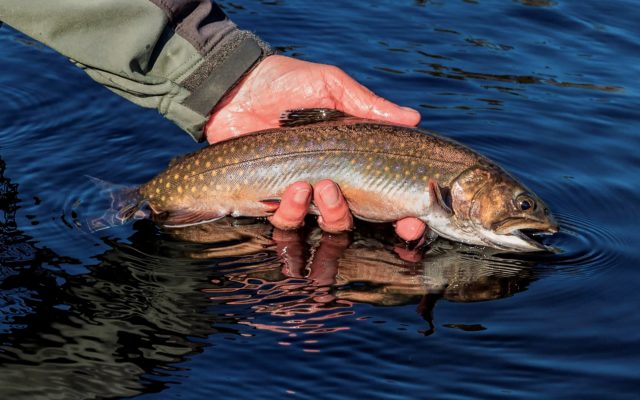
Here’s everything you need to know about brook trout
By Bob Mallard
No species of fish is more synonymous with Maine than brook trout. And you could argue that none is more important to the state. Brook trout are to interior Maine what lobster are to the coast, and as much a part of the North Maine Woods brand as moose and loons.
Brook trout are fascinating fish. Maine is blessed to have several different lifeforms of brook trout. Brook trout are important to Maine, and Maine is important to brook trout. We need to do everything we can, and more than we are doing, to ensure that these unique wild native fish remain viable for generations to come.

Before engaging in conservation-focused topics in future columns, a brief primer on brook trout is in order.
Originally referred to as Salmo fontinalis by naturalist Samuel Latham Mitchill in 1814, brook trout are now referred to as Salvelinus fontinalis. Salvelinus is a genus, and part of the Salmoninae subfamily of the Salmonidae family. The term fontinalis is Latin for “of or from a spring or fountain,” which refers to the cold, clean water where brook trout are found.
Brook trout are often referred to as eastern brook trout, and occasionally, brook charr, common trout, mud trout, salmon-trout, speckled trout and specs. In Maine they are sometimes called squaretail, especially by older anglers. But the most common nickname, and by far, is “brookie.”
The name brook trout is misleading. Brook trout are actually char, not trout, and more closely related to Arctic charr, lake trout, bull trout, and Dolly Varden than they are brown trout, rainbow trout or cutthroat trout. And brown trout are more closely related to Atlantic salmon and landlocked salmon than brook trout.
Brook trout, are, however, the most “trout-like” species of char, and the most adaptable species of salmonid. They are able to live in tiny mountain freestone streams, spring creeks, meadow brooks, flowages, large rivers, small shallow ponds, deep sprawling lakes, brackish water estuaries and even saltwater.
In many of the places they live, brook trout are the predominant species, accounting for over 90 percent of the total fish biomass. This shows that they can live — even thrive — in conditions that many other species of fish cannot, even other salmonids.
Brook trout have been present in the Appalachian Mountains, Great Lakes and eastern Canada for several million years. They are one of the most widely distributed native salmonids in North America, along with Arctic charr and lake trout. As far as the United States goes, brook trout are the most widely distributed native salmonid.
Brook trout are native to Labrador, New Brunswick, Newfoundland, Nova Scotia, Ontario, Prince Edward Island, Quebec and eastern Manitoba. They are found in the United States along the Appalachian corridor from northern Maine to northern Georgia, parts of the Midwest, and most of the Great Lakes region. In many states they are the only native salmonid.
Native to both sides of the southern Appalachian Mountains, brook trout can be found in waters that drain into the Gulf of Mexico as well as the Atlantic Ocean.
The southernmost population of native brook trout in the world is found in northern Georgia in the headwaters of the Chattahoochee River in Chattahoochee National Forest. The northernmost populations are found in extreme northern Quebec.
Unlike many other fish, brook trout are primarily classified at the species not subspecies level. There are however two recognized subspecies of brook trout: Aurora trout and the extinct silver trout of New Hampshire. Best described as a brook trout without patterning or spots, Aurora trout are native to just two lakes in the Temagami District of Ontario.
While the term is often used to describe watershed level populations, there are just two formally recognized strains of brook trout: Northern and Southern. The line denoting Northern versus Southern strain fish is located in the New River drainage in northern Virginia.
Once believed to be subspecies of brook trout, sea-run brook trout, or salters, of the northeastern seaboard, and coaster brook trout of the Great Lakes are now considered life history strategies, or lifeforms, of Northern strain brook trout. Silver trout, an extinct subspecies of brook trout, were once believed to be a form of Arctic charr.
Brook trout can be purely fluvial, living and spawning in moving water. They can also be adfluvial, or born in a stream but living primarily in a lake or pond. Some brook trout live and spawn in lakes and ponds, and are referred to as lacustrine. Massachusetts recently documented what appears to be brook trout spawning in tidal water. All brook trout build redds, or depressions in the gravel.
Newborn brook trout are referred to as alevin or sac fry. They remain in the redd until they exhaust their yolk sac. Brook trout leave the redd as fry, and move into the shallows to feed on zooplankton. The next stage is parr, identified by vertical stripes, which move into deeper water to feed on small insect larvae. The final stages are juvenile and adult.
Brook trout populations are most abundant where good stream spawning habitat is available. In cases where pond-dwelling fish utilize in-lake spawning habitat, populations are usually sparser. This is called recruitment, and high recruitment means high densities; low recruitment means low densities.
Small stream brook trout rarely live more than a few years. In large lakes however, especially in Canada, they can reach up to 10 years old. In ponds and rivers, they fall somewhere in between. The oldest brook trout on record, a nonnative, was close to 25 years old, and found in a high-elevation lake in California.
The largest brook trout on record was 30 inches long with an estimated girth of 20 inches and a weight of 14.5 pounds. It was caught from the Nipigon River in Ontario in July of 1915, and was likely a coaster. In 1827, Daniel Webster caught a sea-run brook trout roughly the same size from the East Connecticut River on Long Island.
Mallard has fly fished for 40 years. He is a former owner of Kennebec River Outfitters, a Registered Maine Fishing Guide and a commercial fly designer. Bob is a blogger, writer and author. He is also a native fish advocate and founding member, executive director and Maine board member for Native Fish Coalition. Look for his books “50 Best Places Fly Fishing the Northeast” and “25 Best Towns Fly Fishing for Trout” (Stonefly Press), and his most recent, “Squaretail: The Definitive Guide to Brook Trout and Where to Find Them” (Stackpole Books). Bob can be reached at BobMallard.com or info@bobmallard.com.